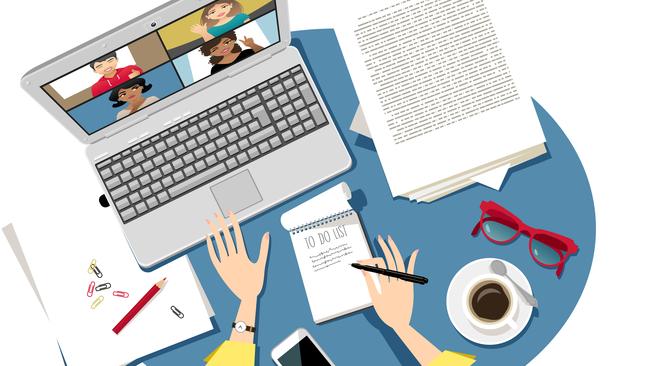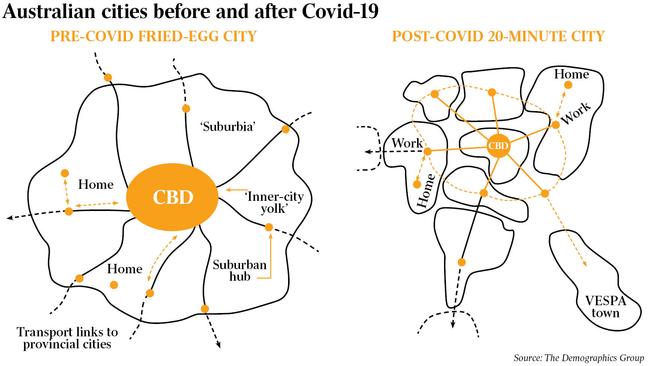How Covid-19 is changing the face of Australian cities
The ‘fried egg’ layout is giving way to a more intimate ‘20-minute’ model.

It is an issue that has taunted Australian town planners for decades: the configuration of our cities. They evolved from a single and dominant CBD with low density housing then spreading outwards in every allowable direction.
The response, via strategic plans developed over the last decade, has been to encourage the development suburban hubs or mini-me CBDs throughout the metro area. Geographers call this the multinucleated city. Planners call it the 20-minute city.
Sydney’s current strategic plan takes the concept of multiple CBDs a step further with plans for three interconnected “cities” focused on the harbour, on Parramatta and on a second airport at Badgerys Creek (near Penrith).
Australia’s capital cities developed mostly during the 20th century. At Federation both Sydney and Melbourne had a population of about half-a-million each, whereas 120 years later they’re both 10 times larger at five million.
Australian cities sprawled outwards from the CBD, often the place of colonial administration, the place upon which the networks for trams, trains and cars converge. Indeed up until the coming of the coronavirus the CBD and its fringes dominated the entire city as a single place of excellence.
THE FRIED-EGG CITY
The most prestigious jobs, shops, restaurants, art galleries, sporting venues were all clustered within, on the edge of, or near to the CBD.
In fact for decades our biggest cities – Sydney, Melbourne, Brisbane and to some extent Adelaide – all resembled a fried egg.
In this model the most prestigious and high-paying knowledge-worker jobs and cultural accoutrement clustered together within a rich creamy yolk. Here is the place of corporates, of visitors, tourists and students and of course more recently, of hipsters.
The low-density flat eggwhite of suburbia spread and sprawled ever outwards – up to 60km on the case of places like (Sydney’s) Penrith and (Melbourne’s) Pakenham.
The problem was that in the fried-egg model of urban development the city operated on the logic that workers were prepared to commute to and from the CBD (and the inner city) every working day for decades.
This arrangement might have suited the baby boomer generation (born 1946-1964) but millennials (born 1984-2002) will not accept it.
Or at least they won’t accept it in the same numbers as preceding generations. The millennials will say there’s a better model, especially in the post-Covid era.

Rise of the 20-minute city
The coming of the coronavirus has been a like bizarre global social experiment where employers and workers have been forced, for two or more years, to work from home.
Between the 1996 and 2016 censuses barely 5 per cent of the workforce worked from home.
During peak lockdowns industry surveys suggested that this figure could have risen to 45-50 per cent.
In my view this proportion will not revert to 5 per cent; it will settle at 10 or 15 per cent.
Every five percentage points this proportion rises off the pre-pandemic base, more than 600,000 commuters are taken off the roads.
Most likely what will emerge in the post-Covid 2020s is a hybrid model of working where workers work two to three days at home and the balance at a workplace.
This shift increases the dwell time in the suburbs; it will have the effect of repurposing the family home and of activating suburban hubs. And the reason why workers will want this model to continue, albeit in a hybrid arrangement, is because it delivers the average Australian a better quality of life.
What therefore emerges in the post-Covid world is a series of interconnected 20-minute cities where workers live, work, play, go to cafes, walk along a bike path and engage with the local community, all within part of the greater metropolitan area.
It’s as if the pandemic, the work-from-home movement and the advent of broadband have all coalesced to create a different (many would day better) version of the cities we left behind.
More workers working from home reduces carbon emissions, is kinder to our collective mental health and defibrillates a series of suburban hubs into action.
Impact on suburbs and CBD
If this view of the future of Australian cities is correct then suburban centres like Sydney’s Parramatta, Blacktown, Liverpool, Chatswood and others would be jump-started into life.
In Melbourne, this hubbing effect might enliven places like Werribee, Footscray, Moonee Ponds, Box Hill, Ringwood and Frankston.
In Brisbane it could be Chermside and Mt Gravatt.
In Perth I am thinking Joondalup and Booragoon or similar.
And in Adelaide this movement could strengthen centres like Noarlunga and Marion on the south side and Elizabeth and Tea Tree Gully non the north side.
So, what’s the impact on the CBD?
The CBD-centricity of the pre-Covid era was always a flawed model.
It’s taken the global shock of Covid to trigger a control-alt-delete rethink.
The old idea was that the CBD holds an authority over the workforce, demanding a daily commute into and out of the city’s yolk.
But from the perspective of 2030, let alone 2040, the idea of a rhythmical fossil-fuel-based commute to and from the CBD will be seen as a waste of time and resources.
If ever there was a people programmed to rail against this thinking, this behaviour, it is the Australians and especially the tech-savvy millennials who were already tetchy about commuting to the extent that they peopled the inner city.
I have heard it said that “you’ll never get a promotion working from home”. I disagree with this logic. In the post-Covid Zoom world workplace prestige will be measured less by who has the corner office and more by who’s produced what output. Take away the office and flatter task-orientated work groups are likely to emerge.
Plus, I think there are many office (and other) workers who aren’t necessarily fixated on getting a promotion. For many workers a job is a job; it pays the mortgage; it supports a family and a lifestyle.

The hybrid workforce
For many workers ‘‘work’’ isn’t the primary focus of their lives. They might work so as to play football or netball or to be more involved in their kid’s lives or to volunteer.
Ask average Aussies whether they’d like to continue working from home, say, two or three days a week and they will grab that opportunity with both hands. They can sell one car. There’s no need for an extensive office wardrobe. And then there’s the commuting time they get back.
The skills required in this new work-from-home arrangement are less focused on “office manoeuvring” and more focused on producing creative, engaging, market-orientated product.
This new arrangement also requires employees to fit in, to make friends, to build relationships. To seamlessly slip into one work team, to deliver to or above expectations, and to then move on, having gained experience, knowledge and strengthened relationships is the way of the future.
The post-Covid workplace winners will be the producers, the creatives, the articulate and the self-confident; those who make friends easily and who are comfortable meeting and working with new people in order to complete a given task.
Future preferences
Let’s say that it’s 2025 and Covid is done and dusted, that a new narrative of urban life has descended upon Australian cities, that customer and worker interactions have digitised, that we’ve recovered much of the flow of people (immigrants, students, visitors) into and out of Australia. What has been the fundamental shift in the demand for property as compared with the pre-Covid year of 2019?
I would say there’s likely to have been a discernible shift in residential demand from the cramped and congested CBD and inner city to the salubrity of the middle and outer suburbs and to regional centres within a Goldilocks zone (of up to 150 km).
The CBD requires every work-from-home worker to return to the office to retain pre-Covid levels of demand (and commercial value).
However, defraying a portion of that ex-CBD office workforce to residential properties scattered across suburbia doesn’t deliver the concentration required to create commercial property value.
It’s like spreading butter thinly over a broad slice of suburban toast rather than heaping it into an enriched CBD pile in the city centre.
There seems to be winners, too, like suburban homes with gardens, sea-change and treechange property and industrial property (for example, logistics centres and smart manufacturing hubs).
There are those who say things will get back to normal in due course.
No they won’t. We’ve moved on; we’ve learnt new skills; we’ve changed our priorities. The one constant throughout this early-2020s ordeal in terms of the Australian way of life is that we are still focused on lifestyle.
The new urban lifestyle
But our ideal of lifestyle has broadened. It’s less likely to a sitting in an inner-city cafe drinking complicated coffee; it’s more likely to be cocooning in the suburbs, in the lifestyle regions, maybe at home working, studying, shopping, completing a Telehealth consultation, watching a Netflix movie and maybe planning a holiday, not necessarily abroad but perhaps to FNQ or to the Kimberley, somewhere that’s safe.
The Australian Covid experience could well mark the end of the fried-egg city and the start of our engagement with 20-minute cities that we’ve decided are just right for cocooning, nesting and Zooming.
Bernard Salt is executive director of The Demographics Group. Graphics by Hari Hara Priyah Kannan.






To join the conversation, please log in. Don't have an account? Register
Join the conversation, you are commenting as Logout